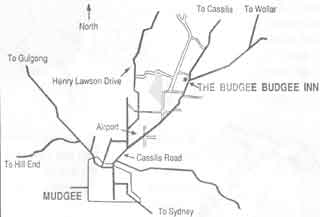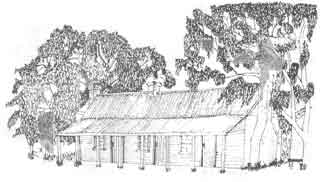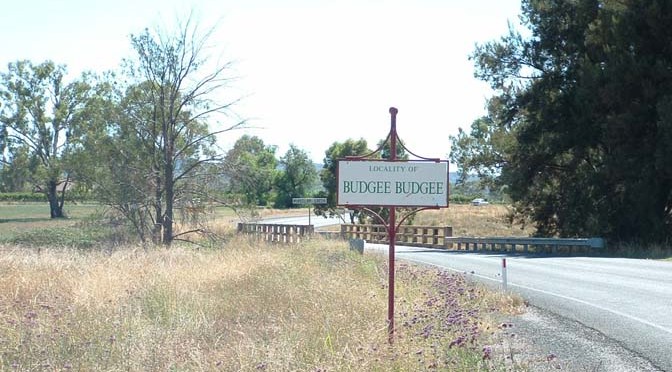Budgee Budgee on the other side of Mudgee is not a village. It is a locality.
The name first appeared on old maps. How the name originated is not known. The name or a close related one does not appear in dictionaries or in lists of “Wiradjuri” (the local clan) or other Aboriginal place names.

The locality is bounded by Pipeclay Creek in the south and ends a few kilometres to the north. It is mainly centred on either side of the Ulan Road (once called the Cassilis Road and many residents still do) and the various lanes that are connected to it.
In 1993 Gil Wahlquist, who was the owner at that time of Botobolar Winery and marketed a white wine named Budgee Budgee was unable to give a definition. Likewise Ross Webb who had restored the Budgee Budgee Inn was unaware as to how the name Budgee Budgee originated.

One local thought the dual Budgee Budgee meant ‘a lot of’ and related to flocks of small parrots or ‘budgerigars’ which once inhabited the area. Another, Belle Roberts, who lived in the area many years ago, recollected it meant a small bush, therefore, lots of small bushes.
Further research led into a strange by-way—the likely interpretation that the 1870s was the era of the rhyming slang of the early settlers and the miners. This was spoken in particular by the Irish larrikin types, teamsters and bullockies who were noted for this method of talking a large number of whom had settled in the area. They simply used Budgee to rhyme with Mudgee.
None of these explanations account for the fact that Budgee Budgee seems to have been on old maps and documents since the early days of settlement when Mudgee was the second oldest white settlement west of the Great Dividing Range.
One of the lanes is Church Lane and an Anglican Church constructed of wood was once there. Likewise there was a school in School Lane.
An entry in Government Schools of New South Wales—1948 to 1998 lists a provisional school at Budgee Budgee from September 1889 to October 1891. From November 1891 until February 1954 it was a public school. At one time it was apparently known as Black Springs until 1905.
Travelling Down The Cudgegong, 3rd edition 1997, page 126, provides additional information on Black Springs and Budgee Budgee schools. There are references to Mr. James Foley the first teacher and John Tierney who recommended him for the position. There is also a photograph of James Foley and pupils at the school.
A big slab dance hall once existed in Black Springs Road. Also a tennis club, one of two in the village, flourished in Black Springs Road. All traces have long disappeared.
In the 1880s, the Budgee Budgee butcher’s shop was the centre of much local activity. In 1896, Elizabeth Tierney who lived at Hill View in what is now Tierney Lane, recorded in her diary that Mr. Huxley, a local butcher killed a pig for her to salt down. A year later, he paid Elizabeth £6 for 3 cows for him to slaughter and sell the meat. Those were simple times when the butcher called weekly with meat for sale in his horse and cart. Country killed meat was much prized.
Today, small clusters of farm homesteads are centred around the Budgee Budgee Inn, the old Budgee Budgee butcher’s shop, and on the Pipeclay Lane where development in recent years has expanded.
The mystery of how Budgee Budgee was named and what it means remains unsolved.


You must be logged in to post a comment.